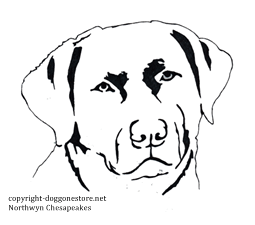|
Conventional
wisdom says that umbilical hernias are inheritable and a dog with a
hernia should not be bred. However, conventional wisdom does not
differentiate between "true hernias" where there is a defect
in the body wall, and "delayed closures", where a small bit of
omentum slips out of the area before the umbilicus closes. In 26 years
of dealing with breeders and reproduction, I do not have any evidence
that "delayed closures" are inheritable.
"True hernias" are indeed highly inheritable. They generally
have a thick cartilage edge with an irregular, more or less circular
shape. They may extend up into the diaphragm, causing a communication
between the thoracic (chest) cavity and the abdominal cavity. These are
very difficult to repair surgically because there is a great deal of
tissue missing and the tissue is hard and inflexible. They often require
the use of a mesh implant to close the defect. These hernias can be
related to other midline defects such as heart abnormalities and cleft
palates. "Delayed closures" are just that. There is an area in
the abdominal wall where the great vessels of the umbilical cord exit
the body of the fetus to derive nutrition and oxygen from the placenta.
After birth, these vessels close and shrink up. There is left behind a
small area in the midline where the vessels formerly escaped the body.
The nature of this structure is a linear slit in the midline, lined with
normal connective tissue. There are other structures on the 'midline'
that undergo similar development after birth. In the heart, there is a
hole between the upper chambers that allows the fetus to bypass the
lungs, which, of course, cannot contribute any oxygen to the blood
before birth. Oxygen is obtained through the umbilical cord from the
placenta, where the mother's blood stream exchanges oxygen and carbon
dioxide with the baby's circulation. When there are delayed closures in
the heart, it may be possible to hear a murmur at 4 or 5 weeks that is
no longer audible by 6 or 8 weeks. This is normal development. These
holes, like the umbilicus, must be present in the fetus and close over a
period of time after birth.
Omentum is a kind of slippery thin sheet of tissue, which is present in
the abdomen. It provides several services to the abdominal organs. It
has blood vessels traveling through it to the intestine. Its surfaces
produce serous fluid which lubricates the abdominal organs and makes it
possible for them to slide against each other without rubbing. It
carries lymph nodes for the abdomen, and is a major depot for fat
storage. It partially contains the abdominal organs -especially the
small intestine-and supports them in a kind of "plastic bag".
As the puppy puts on weight, it is possible for a bit of this thin
slippery tissue to protrude through the umbilical slit. As the normal
process of closing of the umbilicus proceeds, it is possible for this
bit of tissue to be entrapped. The danger here is whether it is solely
omentum that is escaping, or if the defect is large enough for a loop of
small intestine to escape the abdomen as well.
It is essential with either condition to "reduce" the tissue
escaping at least once daily. Turn the puppy on its back and gently
massage the protrusion and slide the contents back up into the abdomen.
This lowers the risk of a loop of intestine becoming strangulated in the
protruding tissue. If the 'hernia' is a closure defect, the normal
process of closing will continue, and at some point a small amount of
omentum may be entrapped in a bubble outside the essentially closed body
wall. This is viewed by most people as a hernia, and a serious problem.
If the dog is a year old, has a small bubble, or 'belly button', and it
cannot be reduced, has been there since it was a baby, and the dog is
healthy and well, it is pretty obvious that the bubble does not contain
any intestine. While the puppy is younger, it may not be clear. The very
tiny holes with a small bubble of omentum do not require surgery.
Slightly larger holes should be closed to be sure that no intestine
becomes strangulated in the process of closure. NOTE: no delayed closure
can ever close completely simply because there is something sticking
through it. If there were no omentum sliding out, they would continue to
close normally. What they do is they close tightly around the omentum,
trapping it outside in an absolutely firm unchanging bubble.
"True"
umbilical hernias can make no progress in closing, ever. They must
always be surgically repaired. These individuals should never be bred.
These are quite serious. I have never seen a bitch with a delayed
closure and trapped omentum bubble show any sign of problem in carrying
a litter or whelping. I have never seen one of these bitches produce
puppies with hernias.
The
catch is, you must know which you have. Most veterinarians don't draw
these kinds of conclusions or try to differentiate the two different
conditions. Your vet may or may not be of help to you in this.
Breeders with years of experience often know the difference intuitively.
Indeed, since "true" hernias are relatively rare, most have
never seen one, unless they are breeding a line that produces them. In
these cases, they see true hernias with great enough frequency that any
breeder with any common sense will/should abandon that line.
See
this article at
Super
Dog Show Site
Always
consult with your Veterinarian for treatment or before treating your dog
with any medication |

